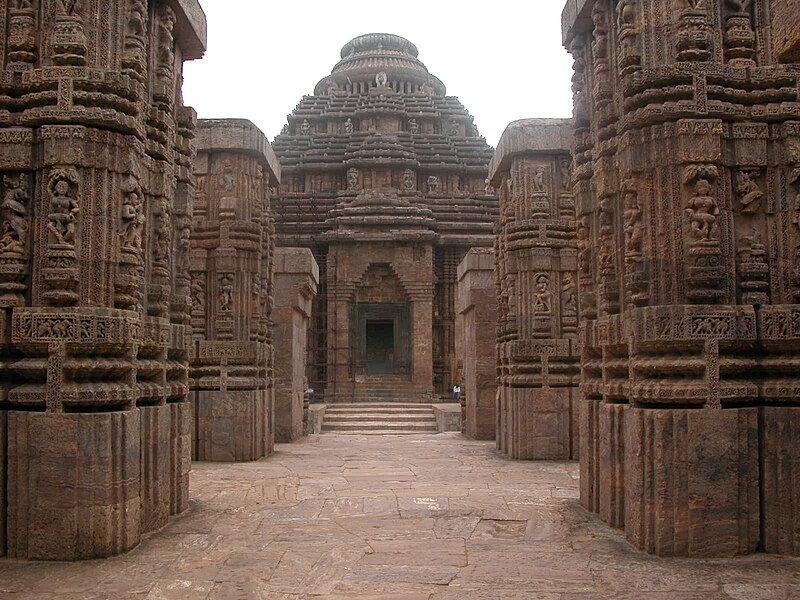
Nestled on the eastern coast of India in the state of Odisha lies the ancient town of Konark, renowned for its magnificent Sun Temple, a UNESCO World Heritage Site and one of the most iconic monuments of Indian architecture. Steeped in myth, legend, and architectural splendor, Konark offers visitors a journey through time, where the grandeur of its temple complex and the richness of its cultural heritage converge to captivate the imagination. From its intricately carved sculptures to its celestial alignment with the sun, Konark stands as a testament to the ingenuity and artistic prowess of India’s ancient craftsmen.
Historical Background: Konark’s history dates back over a thousand years, with its origins shrouded in myth and legend. The town was once a bustling center of maritime trade and cultural exchange, serving as a gateway to the ancient Kalinga kingdom. It reached its zenith of glory during the reign of King Narasimhadeva I of the Eastern Ganga dynasty in the 13th century, who commissioned the construction of the iconic Sun Temple.
Architectural Marvel: The Sun Temple of Konark, built in the 13th century CE, is a masterpiece of Kalinga architecture and a testament to the artistic and engineering prowess of its creators. Designed in the shape of a colossal chariot, with twelve intricately carved wheels representing the twelve months of the year, the temple is dedicated to Surya, the Sun God, and is adorned with thousands of exquisitely carved sculptures and reliefs.
The temple’s main sanctum, or “garbhagriha,” once housed a massive stone idol of the Sun God, which is said to have been suspended in mid-air through the use of magnetic forces. Although the idol is no longer present, the temple’s architectural grandeur and sculptural beauty continue to awe and inspire visitors from around the world.
Intricate Sculptures: The Sun Temple of Konark is renowned for its intricate sculptures, which adorn its walls, pillars, and doorways, depicting a wide range of mythological, religious, and secular themes. The sculptures are a testament to the artistic skill and craftsmanship of the ancient artisans, who painstakingly carved each detail with precision and finesse.
Among the most famous sculptures of Konark are the erotic carvings, known as “mithunas,” which depict scenes of love, passion, and sensuality. These sculptures, though controversial, are considered integral to the temple’s iconography and are believed to symbolize the eternal cycle of creation and procreation.
Celestial Alignment: One of the most intriguing aspects of the Sun Temple is its celestial alignment with the sun. The temple is designed in such a way that the first rays of the rising sun illuminate the main entrance, casting a divine glow on its sculpted walls and reliefs. This architectural feat is a testament to the ancient builders’ knowledge of astronomy and their reverence for the sun as a symbol of life, energy, and cosmic order.
Cultural Heritage: Konark is not only famous for its architectural marvels but also for its rich cultural heritage and vibrant traditions. The town is home to several annual festivals and cultural events, including the Konark Dance Festival, which celebrates the classical dance forms of Odissi, Bharatanatyam, and Kathak, among others. Held against the backdrop of the Sun Temple, the festival attracts renowned dancers and musicians from across India and abroad, who perform to enthralled audiences under the open sky.
Preservation Efforts: As a UNESCO World Heritage Site, the Sun Temple of Konark is subject to ongoing preservation and conservation efforts aimed at safeguarding its architectural integrity and historical significance. Restoration work, including cleaning, consolidation, and structural repairs, is carried out periodically to ensure that the temple remains structurally sound and aesthetically preserved for future generations to appreciate.
In addition to physical conservation measures, efforts are also underway to raise awareness about the temple’s cultural and historical importance, both locally and internationally. Educational programs, guided tours, and interpretive signage help visitors understand the significance of Konark as a symbol of India’s rich heritage and artistic legacy.
Conclusion: Konark, with its magnificent Sun Temple and rich cultural heritage, stands as a shining beacon of India’s ancient civilization and architectural brilliance. As visitors wander through its labyrinthine corridors, marvel at its intricate sculptures, and bask in the divine glow of the rising sun, they are transported to a bygone era of myth and legend, where gods walked the earth and mortals aspired to transcendence.
Amidst the timeless beauty of Konark’s Sun Temple, one finds a sanctuary of serenity and wonder, where the mysteries of the cosmos and the splendor of human creativity converge in a symphony of stone and sunlight. As we celebrate the legacy of Konark and its enduring significance, let us also pledge to preserve and protect this precious gem of India’s cultural heritage for generations to come, ensuring that its story continues to inspire and enrich the tapestry of human civilization.




